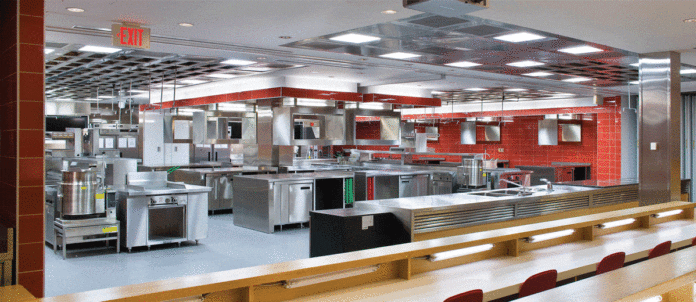[dropcap size=big]I[/dropcap]nduction equipment is heating up, as supply expands to fit growing needs. Product lines have multiplied to include everything from countertop single and multi-hob burners to drop-in warming units, woks and planchas (for grilling). There’s even talk about induction fryers coming to market soon. And, induction technology is finding a home in kitchen suites across the country.
In Toronto, the Humber College culinary induction labs showcase the latest innovations. Shonah Chalmers, program coordinator for the school’s Culinary Skills and Culinary Management program, says it’s very much in keeping with the future direction of cooking. “Today, convection is primarily found on the baking and pastry side; and traditional gas or
combi-ovens comprise the bulk of cooking needs,” she says. “But many more [chefs] are using induction, and we wanted to be on the edge. Students need that exposure.”
At Humber, induction technology is integrated into two cooking suites used by chef instructors. The islands combine four-burner induction cooktops with convection ovens and under-the-counter refrigeration
and storage. Students work on smaller suites with two burners and
gas ovens.
Patrick Watt, consultant with A Day in Life Foodservice Development in Saint John, N.B., confirms induction is playing a big role in island suite designs. “Garland [in Mississauga, Ont.] has built some heavy-duty induction units that drop in nicely to an island suite. [Stockholm-based] Electrolux has also done well with this,” he says. And, incorporating induction cooktops into suite designs helps create narrower surfaces, making a smaller footprint that requires less ventilation. “Then you can do raised grills and drop-in fryers,” Watt adds. “The big leap however is in warming capabilities, which I wouldn’t be surprised to see go into island suites soon.”
Suites can be configured to incorporate holding drawers, refrigeration, plumbing and garbage disposal functions. Add-ons can also include pass-through and overhead shelves as well as rails and specialty warmers. “Culinary schools really love them; their suites have pizzazz. I’ve also seen small, basic ones at café sites,” the consultant says.
Tod Olson, project manager for Trimen Food Service Equipment, Inc., a distributor in Toronto, won a 2011 Montague Suite Dreams Design competition. Since then he has witnessed many cooking suite innovations. “[Induction is] getting integrated more and more into suites,” he notes, adding that induction burners give more options for fitting fridges and ovens into cooking suites. “Before ovens had to be placed directly under elements. Now you have much more flexibility.”
The best suites have a single point of connection for gas, electrical and water/drainage. “When it comes to doing rough-ins, you only have to run one connection into the curb mounting. That’s a benefit on the construction side,” Olson notes.
At Holland College’s Canada’s Smartest Kitchen, a research and development centre in Charlottetown, a substantial cooking suite with six induction burners is used for product development. Four people can work comfortably on it, says Michael Bryanton, research and development chef. Add-ons include a grill, charbroiler and below-the-counter refrigeration units. There is also a built-in sink, work surfaces and a garbage collection space. “Having something in the centre of the kitchen is a great benefit location-wise, because we can place other equipment around the perimeter. It’s a good way to maximize space,” says Bryanton. The unit is stationary to enable hardwiring for induction and plumbing.
And, while a suite suits a research centre’s needs, it’s not always the right choice for all operations. “I can see it in a hotel prep kitchen, but sometimes you get a better workflow in a typical linear setup, depending on the menu and if you need to configure set pieces,” says Bryanton.
Olson agrees that not all kitchens are ideal for a cooking suite. “You need to have a full walk-around area, because you are working with twice as much depth as a standard setup where you have the hood against one wall and workspace and cold prep on the opposite side,” he says, adding that the latest innovation he has seen is a single-depth, double-sided suite design.
A kitchen suite can also be difficult to reconfigure since it’s highly customized. And if the kitchen is running gas, it requires a chimney, which could restrict flexibility when designing a system. “The upside is you can do some funky things with design. Montague out of [Hayward] California has some of the nicest ones,” Watt notes.
Jordan Prescesky, VP, Research and Develop- ment for Calgary-based Franworks Group of Companies, which operates locations under the Original Joe’s Restaurant & Bar, State & Main Kitchen Bar as well as Elephant & Castle Pub and Restaurant brands, understands the limitations of small spaces. “A middle island can take up a ton of kitchen space, because you need so much area around it. Without a linear [configuration], refrigeration setup can be tough,” Prescesky says, noting that his kitchen operations are run within 3,900 to 5,300 sq. ft.
Price, like space, can also be a challenge when considering the installation of a cooking suite. “Take the cost of a normal cooking line and add 30 to 40 per cent to that, because of the finishing, detailing and assembly involved,” Watt says.
But, suite or no suite, there is one unusual problem chefs should beware of when working with induction, according to Susan Somerville, dean of the School of Hospitality, Recreation and Tourism for Hum- ber College. It turns out some chefs ruined their computers when placing them near the stovetops, which have magnetic properties. “They learned the hard way,” she quips.


















